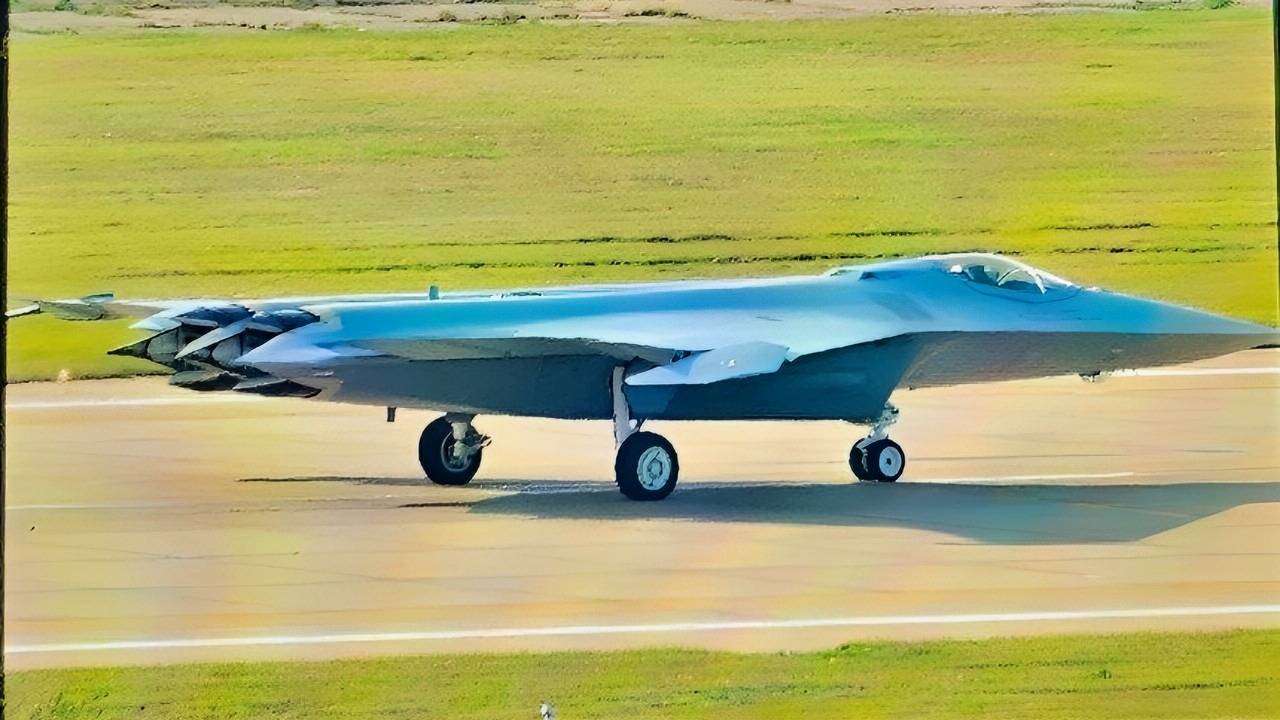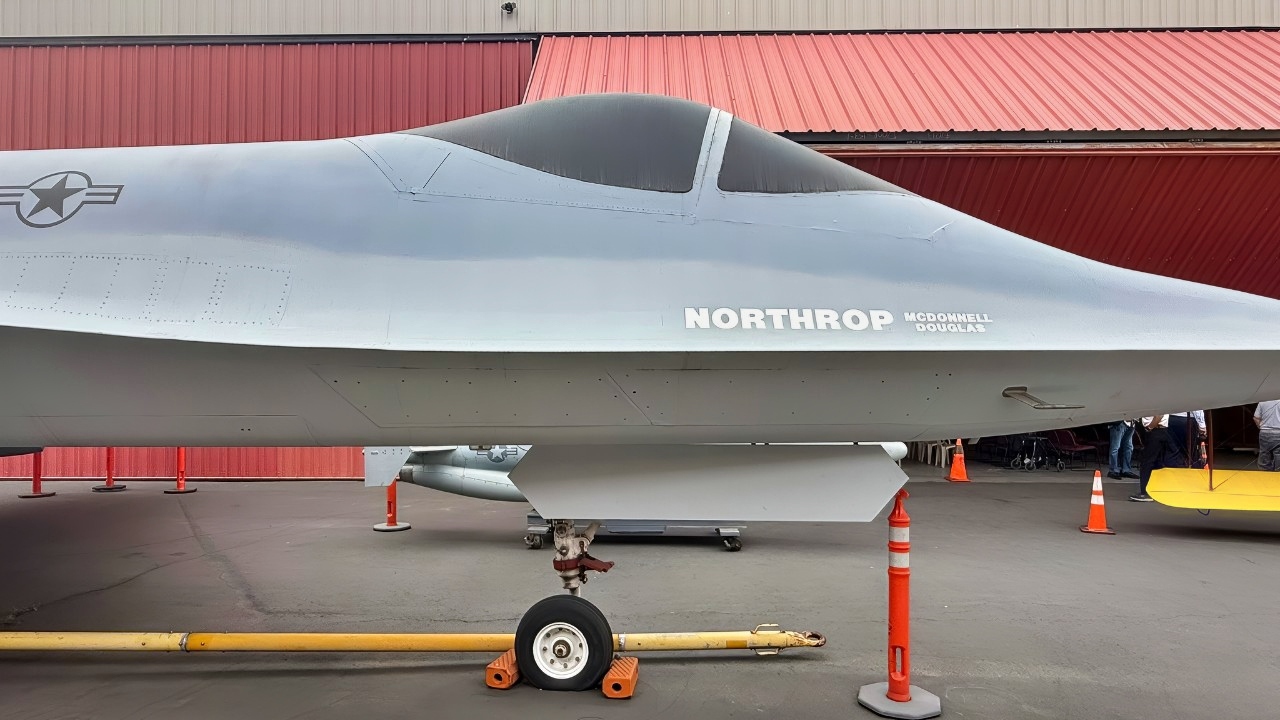Key Points and Summary – Experts warn that America’s F-47 sixth-generation fighter is already three to four years behind China’s J-36 and J-50, which reportedly began flight testing in 2024.
-Beijing has shown it can move from CAD to prototype to flight far faster than the U.S., just as it did with the J-20, which entered service only six years after its first flight.

Shown is a graphical artist rendering of the Next Generation Air Dominance (NGAD) Platform. The rendering highlights the Air Force’s sixth generation fighter, the F-47. The NGAD Platform will bring lethal, next-generation technologies to ensure air superiority for the Joint Force in any conflict. (U.S. Air Force graphic)
-By contrast, America’s F-22 took 15 years to go from YF prototype to operational status.
-With a shrinking defense industrial workforce and chronic funding shortfalls, Johnson argues the U.S. risks ceding next-generation air dominance to a more agile China.
The F-47 is Three to Four Years Behind the Chinese
According to Military Watch, the outgoing US Air Force (USAF) Chief of Staff, General David Allvin, stated on November 12 that the Boeing F-47 sixth-generation fighter would make its first flight in 2028.
This, as the online magazine points out, “represents the most explicit public reference to the fighter program’s flight timeline by officials so far.”
Initially, USAF officials had projected that the F-47’s first flight would take place before the end of US President Donald Trump’s term in office, which would officially conclude on Inauguration Day, January 20, 2029.
The program has overall seen a slowdown in progress due to several pronounced funding shortfalls impacting major USAF projects.
However, the funding shortfall occurred before two separate Chinese sixth-generation fighters, which have been referred to as the Chengdu J-36 and the Shenyang J-50/XD, were seen flying in videos posted on Chinese social media sites.

J-50 Fighter Image from X
These “unofficial” videos were shared on aviation enthusiast internet accounts (probably not coincidentally) on the occasion of the 24th anniversary of the birth of the founder of the People’s Republic of China (PRC), Mao Zedong, on December 24, 2024.
Should the F-47’s first flight actually occur by 2028, as planned, this would still put the US’s development of a 6th-generation fighter three to four years behind the PRC’s own analogous programs.
If there were any additional delays in the flight testing of the F-47 program, it would only put the US further behind the progress the Chinese design teams have made to date.
Leapfrogging the US
The PRC aerospace industry is demonstrating how much more rapidly they can complete the CAD concept-to-prototype-to-flight-test cycle than we can in the US.
“It literally is a new definition of what we used to call ‘rapid prototyping,'” said one of the former senior-rank US military officials advising the US program effort.
Unfortunately for the USAF, the PRC has demonstrated a notable ability to “leapfrog” over US industry in more than one respect. The US YF-22 and YF-23 prototypes competed in a fly-off in 1990, but the 5th-generation F-22 did not enter service until 2005.

YF-23A Black Widow II on Display at Museum. Image Taken by National Security Journal on August 19, 2025.
In comparison, the PRC flew its first 5th-generation jet in 2011 but then entered service with the PLA Air Force (PLAAF) only six years later.
If this pattern repeats itself, Beijing will be fielding operational 6th-generation fighter jets as early as 10 years before the US would be capable of doing the same.’

J-36 Fighter from China. Image Credit: Creative Commons.
More recent reporting from media based in the PRC indicates even faster-paced progress in the prototype and design validation phase.
Moreover, the appearance of different versions of the prototypes for the two aircraft shows that verification of the design is well underway.
These changes in the prototype designs, made in only 10 months, are assessed as progress toward series production or, at the very least, a low initial rate of production, and are considered “accelerated.”
Works in Progress
However, using the J-20 as a case study, the argument could be made that, while the J-20 entered service only a few years after its first “official” flight, the aircraft remained a work in progress for several years.
Most notably, J-20s were produced with three different engines installed until the powerplant originally intended for it, the WS-15 Emei, was finally seen flying in 2023.
But the USAF remains at an increasing disadvantage vis-à-vis the PLAAF nonetheless. The force’s currently estimated fleet of nearly 5,000 aircraft is today the smallest in its 78-year history.
But what is more likely to put distance between the US and PRC is the fact that the current workforce of the US defense industrial base has been contracting since the end of the Cold War.
The number of personnel working for major defense contractors is between one-half and one-third of what it was 40 or more years ago, depending on how you count, of its size.’

J-36 Fighter Artist Rendition from X Screenshot
“This will not change until the prospect of a job in the defense sector becomes far more attractive than it is today,” said a retired US defense industry executive. “It has to become something that has halfway decent job security and the personnel management has to become intelligent and relevant again.”
“There is something wrong when our defense corporations’ HR departments can recite the ‘DEI manifesto’ by heart, but they have no clue about how to set up one of their US employees to work in a foreign country and want to farm out all those positions to local nationals,” he continued. We depend on foreign sales to create economies of scale in defense production, but like everything else we do now, it has been outsourced.”
About the Author: Reuben F. Johnson
Reuben F. Johnson has thirty-six years of experience analyzing and reporting on foreign weapons systems, defense technologies, and international arms export policy. Johnson is the Director of the Asia Research Centre at the Casimir Pulaski Foundation. He is also a survivor of the Russian invasion of Ukraine in February 2022. He worked for years in the American defense industry as a foreign technology analyst and later as a consultant for the U.S. Department of Defense, the Departments of the Navy and Air Force, and the governments of the United Kingdom and Australia. In 2022-2023, he won two awards in a row for his defense reporting. He holds a bachelor’s degree from DePauw University and a master’s degree from Miami University in Ohio, specializing in Soviet and Russian studies. He lives in Warsaw.
More Military
Could America Have Lost the Revolutionary War?
The Marines Don’t Have Tanks Anymore
The Essex-Class Aircraft Carriers Have An Embarrassing Message for the U.S. Navy
‘New’ Mach 4 MiG-41 6th Generation Stealth Fighter Has Warning for U.S. Air Force
Boeing’s F-47 NGAD 6th Generation Stealth Fighter Is No ‘Mission Impossible’










